Welcome to my fruit fly season guide! As we approach the fall harvest season, it’s important to be aware of the increase in fruit fly activity. Fruit flies are small flies that are attracted to ripe, decaying, or fermenting food. They can be found in garbage, compost piles, and garden areas, making them a nuisance in both residential and commercial settings.
But fruit flies aren’t just annoying pests. They can also pose a health risk, as they are capable of carrying and spreading bacteria and pathogens that can make people ill. That’s why it’s crucial to take measures to control and prevent fruit fly infestations.
Key Takeaways:
- Fruit flies are most active during the fall harvest season.
- They are attracted to ripe, decaying, or fermenting food.
- Fruit flies can carry and spread harmful bacteria and pathogens.
- Professional pest control services can effectively control fruit fly infestations.
- Preventive measures include regularly removing trash, washing dishes, and inspecting fruits and vegetables.
What do fruit flies look like?
Fruit flies are small flies that measure about 1/8th of an inch in length. They have red, brown, or black eyes and translucent wings. The bodies of fruit flies are usually black on top and gray on the underside, appearing tan to the human eye.
Fruit fly larvae, also known as maggots, are worm-like in appearance and whitish in color except for their two dark-colored mouth hooks. Fruit flies lay their eggs on ripe, decaying, or fermenting food, which hatch into larvae and develop into adult flies.
What Attracts Fruit Flies?
When it comes to fruit flies, their attraction lies in the presence of ripe fruit and decaying food. These tiny pests can quickly become a nuisance and infest homes or businesses if exposed to infested food or eggs. They are commonly found in areas with garbage, compost piles, or garden areas. If there’s already a fruit fly infestation, they are particularly drawn to fruits and vegetables that are already infested with fruit flies or their eggs. To safeguard against their invasion, it’s crucial to take preventive measures, such as properly sealing jars and cans to prevent fruit fly infestations.
“Fruit flies are opportunistic pests that seek out environments with access to ripe fruit and decaying food. They are attracted to the sweet scent emitted by fermenting substances, making them a common presence in kitchens, pantries, and areas where food waste is present.”
When fruit flies find their way into our living spaces, they can quickly reproduce and establish an infestation. By understanding their attraction to ripe fruit and decaying food, we can take steps to prevent their infestation and protect our homes and businesses from these persistent pests.
Are fruit flies dangerous?
Yes, fruit flies can be dangerous, especially when found in kitchens, pantries, and other areas where food is stored or prepared. Fruit flies are not just annoying pests; they can also pose health risks due to their ability to pick up bacteria and pathogens on their bodies and legs as they feed, breed, and travel. These tiny insects can become carriers of various harmful microorganisms that can cause illness in humans.
Fruit flies are attracted to ripe, decaying, or fermenting food, and they can easily infest fruits, vegetables, and other organic matter. During their feeding and breeding process, fruit flies can come into contact with bacteria, such as E. coli and Salmonella, as well as other pathogens that can lead to foodborne illnesses.
When these contaminated fruit flies come into contact with food or food preparation surfaces, they can unwittingly contaminate them with bacteria and pathogens. This can result in potential health hazards if ingested by humans, leading to symptoms such as stomach upset, diarrhea, and even more severe illnesses in certain cases.
Therefore, it is crucial to take fruit fly infestations seriously and eliminate them promptly to minimize the risk of bacterial contamination and ensure food safety in your home or business.
My personal experience with fruit fly infestations
“A few years ago, I encountered a fruit fly infestation in my kitchen. At first, I didn’t think much of it, as they seemed harmless. However, after some research, I discovered the potential health risks associated with these seemingly harmless flies. It alarmed me to think that these tiny insects could be carrying bacteria and pathogens that could make me and my family sick.”
“I immediately took action to eliminate the infestation, employing various methods such as cleaning, sanitizing, and removing all potential breeding sites. It was a thorough and painstaking process, but the peace of mind in knowing that we were creating a safer environment for ourselves was worth it.”
“Since then, I have taken preventive measures to minimize the risk of fruit fly infestations, including regular cleaning, proper food storage, and sealing any potential entry points for these pests. By staying vigilant and proactive, we can prevent the dangers associated with fruit flies and maintain a healthy living space.”
It is essential to emphasize that eliminating fruit flies goes beyond just swatting them away. It requires a comprehensive approach that includes proper sanitation, eliminating breeding sites, and employing effective pest control measures. By addressing and preventing fruit fly infestations, you can protect yourself, your loved ones, and your customers from potential health hazards.
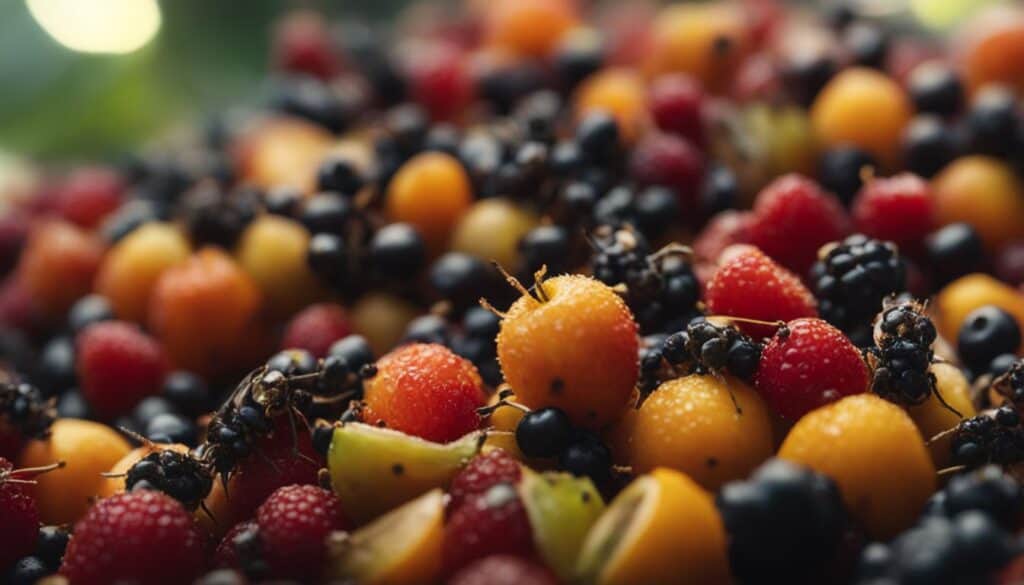
Protecting against fruit fly infestations
To protect against fruit fly infestations and the associated health risks, here are some important steps to consider:
- Regularly clean and sanitize your kitchen, pantry, and other food storage areas.
- Keep fruits and vegetables stored properly, either in the refrigerator or in sealed containers.
- Inspect and discard any overripe, decaying, or damaged produce.
- Dispose of food waste promptly and ensure garbage cans have tight-fitting lids.
- Seal any cracks or gaps in windows, doors, and screens to prevent fruit flies from entering your home or business.
- Consider using fruit fly traps or enlisting the help of a professional pest control company to eliminate and prevent infestations.
By taking these preventive measures, you can reduce the risk of fruit fly infestations, minimize the spread of bacteria and pathogens, and ensure the safety of your food and environment.
Fruit fly control
To effectively control fruit flies, it is crucial to take swift action and implement appropriate measures. While fruit fly traps can help capture these pesky pests, they do not address the source of the infestation. To achieve long-term control and prevent future infestations, it is recommended to contact a professional pest control company specializing in fruit fly control.
A pest control company will conduct a thorough inspection of your property to identify the extent of the infestation and determine the most effective course of action. They have the expertise to accurately identify the specific fruit fly species and develop a customized treatment plan tailored to your situation.
In commercial facilities, fruit fly control may involve drain bio-remediation to eliminate breeding sites. This comprehensive approach ensures that all potential areas of fruit fly activity are addressed, reducing the risk of reinfestation.
By enlisting the services of a reputable pest control company, you can benefit from their knowledge, experience, and access to professional-grade products and techniques specifically designed for fruit fly control. This will give you the peace of mind knowing that the infestation is being effectively addressed.
Key Points:
- Contact a professional pest control company for fruit fly control
- Fruit fly traps do not address the source of the infestation
- Professional services include accurate identification and customized treatment plan
- In commercial facilities, drain bio-remediation may be necessary
Remember, timely and effective fruit fly control is crucial to prevent these pests from multiplying and causing further infestation. Act now and engage the services of a professional pest control company to eliminate fruit flies from your property.
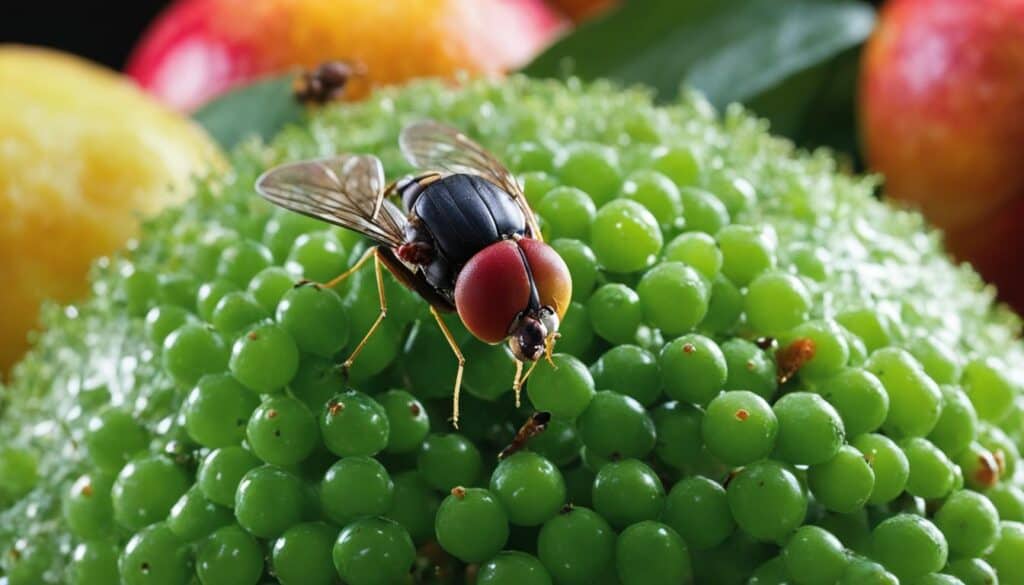
Fruit fly prevention tips
Preventing fruit fly infestations is a crucial step in maintaining a clean and pest-free environment. By following these essential tips, you can help keep fruit flies at bay and protect your home from their nuisance.
Proper trash removal
Regularly removing trash and disposing of it properly is an effective way to deter fruit flies. Make sure to place your trash in containers with tight-fitting lids to prevent flies from accessing it. The odor emanating from decaying organic matter can attract fruit flies, so maintaining good sanitation practices is key.
Sanitizing trash receptacles
Routinely washing and disinfecting your trash receptacles can help eliminate any fruit fly eggs or larvae that may be present. Cleaning these containers with a mixture of soap and water, followed by a disinfectant, can significantly reduce the chances of attracting fruit flies.
Fixing leaky fixtures and pipes
Fruit flies are attracted to moisture sources, so it is essential to repair any leaky fixtures or pipes in your home. Eliminating these damp environments will make your home less inviting to fruit flies and discourage them from breeding.
Maintaining clean drains
Regularly cleaning and ensuring that drains are free of debris can help prevent fruit flies from finding a suitable breeding ground. Fruit flies can thrive in moist areas like drains, so maintaining proper hygiene in these areas is essential.
Inspecting produce
Prior to purchasing fruits and vegetables, it’s important to carefully inspect them for any signs of fruit flies. Look for tiny puncture marks or small, flying insects around the produce. Avoid purchasing any items that appear to be infested to prevent bringing fruit flies into your home.
Refrigerating fruits and vegetables
Storing fruits and vegetables in the refrigerator instead of leaving them out on kitchen counters can help prevent fruit fly infestations. The cool temperature inside the refrigerator slows down the ripening process and deters fruit flies from laying their eggs on the produce.
By practicing these fruit fly prevention tips, you can create an environment that is less attractive to these pesky insects. Maintaining proper sanitation, inspecting produce, and taking proactive measures will help you keep fruit flies at bay and enjoy a pest-free home.
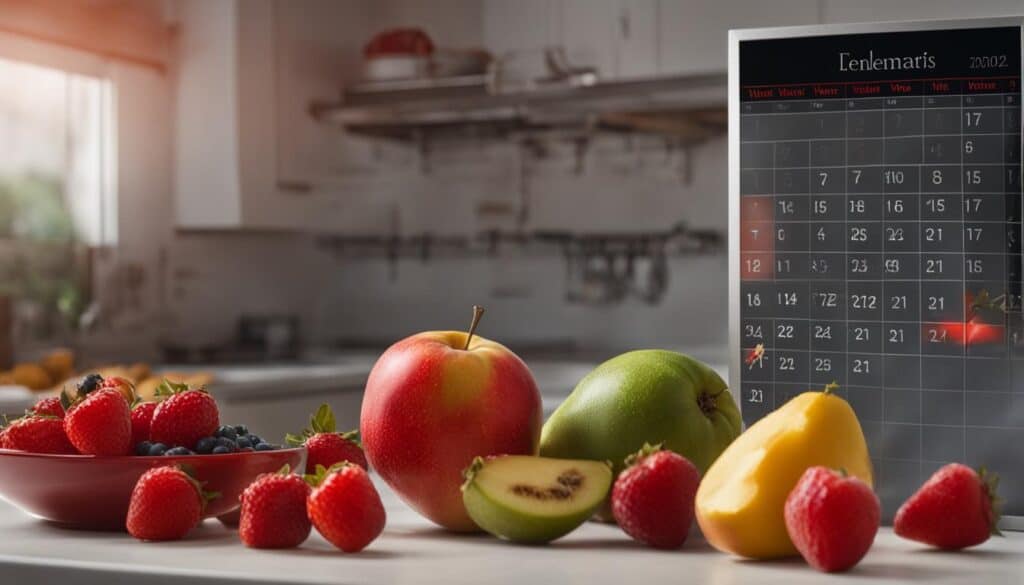
Introduction to Managing Fruit Flies in Hawai’i
Managing fruit flies in Hawai’i is a crucial task to ensure the health and productivity of agricultural crops. As a diverse region with unique ecosystems, Hawai’i is home to four distinct species of fruit flies that pose significant challenges to fruit production and export. These species include the oriental fruit fly, melon fly, Mediterranean fruit fly, and solanaceous fruit fly.
Fruit Fly Species in Hawai’i:
| Fruit Fly Species | Preferred Habitats |
|---|---|
| Oriental Fruit Fly | Found in most climates |
| Melon Fly | Commonly found in low areas in commercial and backyard vegetable gardens |
| Mediterranean Fruit Fly | Thrives in upper elevations and low-elevation coffee fields |
| Solanaceous Fruit Fly | Survives in both cool and hot climates |
Source: “Managing Fruit Flies in Hawai’i” (2021), Department of Agriculture, State of Hawai’i.
These fruit fly species belong to the Family Tephritidae in the Order Diptera. They have adapted to various climatic conditions and feed on hundreds of host plants, posing a significant threat to Hawaii’s agriculture industry. It is crucial to understand their behavior, life cycle, and preferred habitats to develop effective management strategies.
Minimizing fruit fly populations requires comprehensive pre-harvest fruit fly management programs. These programs aim to reduce fruit fly infestations and prevent their spread to ensure the quality and safety of harvested fruits. By implementing proactive measures, farmers and agricultural professionals can protect crops and minimize economic losses.
Damage caused by fruit flies
Fruit fly adults lay their eggs in the fresh flesh of fruits and vegetables, and the hatching larvae often feed on the inside of the fruit, resulting in a soft, mushy texture. This damage can render the affected fruits and vegetables unsuitable for consumption, leading to economic losses for growers and sellers. The presence of fruit fly larvae in harvested crops can also lead to rejection by buyers and consumers, further impacting the profitability of agricultural businesses.
Fruit fly damage is particularly significant in crops that have high market value, such as exotic fruits and specialty vegetables. For example, in the Hawaiian Islands, fruit flies pose a serious threat to valuable crops like papaya, guava, and tomatoes. The economic injury caused by fruit fly infestations in these crops can be substantial, affecting both the quantity and quality of harvests.
To illustrate the extent of economic injury caused by fruit flies, consider the case of a papaya farm in Hawaii. A single female fruit fly can lay hundreds of eggs, and each egg has the potential to develop into a damaging larva. If left unchecked, fruit fly infestations can reduce harvest yields by up to 50% or more, resulting in significant financial losses for farmers.
Fruit fly damage in papaya crops:
| Year | Estimated economic losses (in USD) |
|---|---|
| 2018 | 500,000 |
| 2019 | 750,000 |
| 2020 | 1,000,000 |
The table above shows the estimated economic losses due to fruit fly damage in papaya crops over a three-year period. As demonstrated, the financial impact of fruit fly infestations can escalate rapidly, underscoring the need for effective fruit fly control and prevention strategies.
By implementing comprehensive pest management practices and taking proactive measures to combat fruit fly infestations, agricultural stakeholders can mitigate economic injury and preserve the value of their crops.
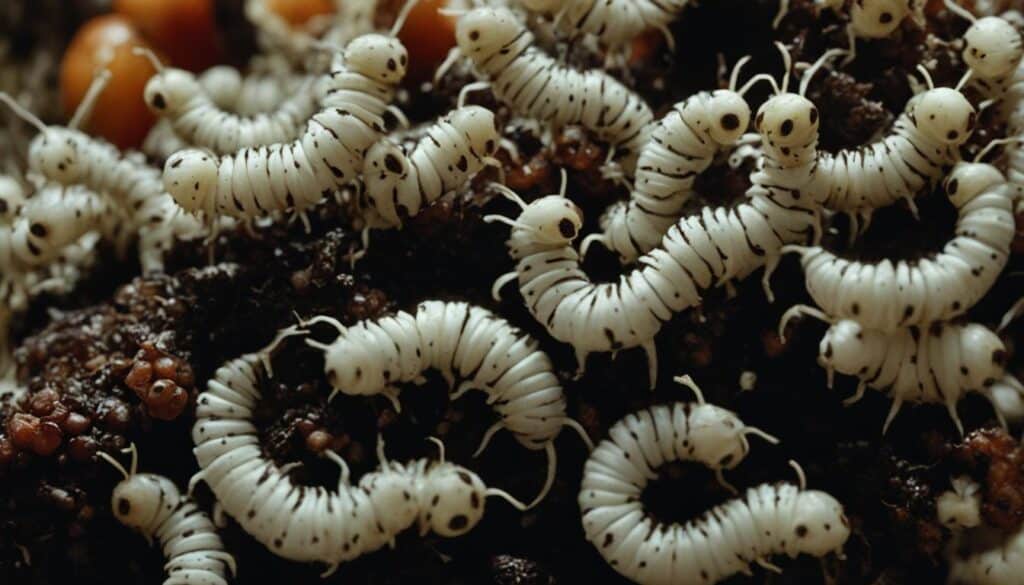
Prevention strategies for fruit fly damage
Preventing fruit fly damage is essential to protect your crops and maintain a healthy ecosystem. By implementing effective sanitation techniques, creating a favorable environment, and using exclosure methods, you can significantly reduce the risk of fruit fly infestations and associated damage.
Sanitation techniques
Proper sanitation plays a crucial role in fruit fly prevention. By removing fruits and other organic materials that attract fruit flies, you can eliminate potential breeding grounds. Regularly clean up fallen or overripe fruits from your orchard or garden, ensuring that there is nothing enticing for fruit flies to feed on.
Creating a healthy ecosystem
A healthy ecosystem with robust plants, nutrient-rich soils, and diverse beneficial organisms can enhance your crops’ natural defenses against fruit flies and other pests. By maintaining soil fertility, practicing crop rotation, and promoting biodiversity, you can create an environment that discourages fruit fly infestations.
Exclosure methods
Using exclosure methods like screen houses, netting, or fine mesh can physically prevent fruit flies from accessing your fruits. These barriers act as an effective deterrent, keeping fruit flies at bay while still allowing air and light to reach the plants. Bagging individual fruits with paper bags or other barriers can also provide protection against fruit fly damage.
“Implementing exclosure methods, such as using screen houses or netting, can significantly reduce fruit fly damage and protect your crop investment.” – Fruit Fly Prevention Expert
Minimizing stress on plants
Stressed plants are more vulnerable to fruit fly infestations. To prevent stress-related damage, ensure proper irrigation, weed control, and nutrient management. Regularly monitor your plants for signs of stress and promptly address any underlying issues to maintain plant health and resilience against fruit flies.
Monitoring and evaluation
Implementing a monitoring and evaluation strategy is vital to detect fruit fly infestations early and take prompt preventive action. Regularly inspect your crops for adult fruit flies, larvae, or any signs of fruit damage. By closely monitoring the population levels and implementing appropriate control measures when necessary, you can minimize fruit fly damage and protect your harvest.
Comparing Prevention Strategies for Fruit Fly Damage
| Prevention Strategy | Advantages | Disadvantages |
|---|---|---|
| Sanitation techniques | – Eliminates breeding grounds – Reduces attractive food sources – Low-cost and environmentally friendly | – Requires regular maintenance – Relies on consistent implementation |
| Creating a healthy ecosystem | – Strengthens plant defenses – Enhances biodiversity – Long-term sustainability | – Requires knowledge and expertise – May take time to establish |
| Exclosure methods | – Physically prevents fruit fly access – Provides targeted protection – Allows airflow and light | – Requires installation and maintenance – Can be costly for larger areas |
| Minimizing stress on plants | – Enhances plant health and resilience – Reduces susceptibility to infestations – Improves crop quality | – Requires ongoing care and monitoring – May not eliminate infestations entirely |
| Monitoring and evaluation | – Early detection of infestations – Timely implementation of control measures – Prevents widespread damage | – Requires regular monitoring – Relies on accurate identification – May involve additional labor |
By combining these prevention strategies and tailoring them to your specific needs, you can effectively protect your crops from fruit fly damage and maintain a vibrant and productive orchard or garden.
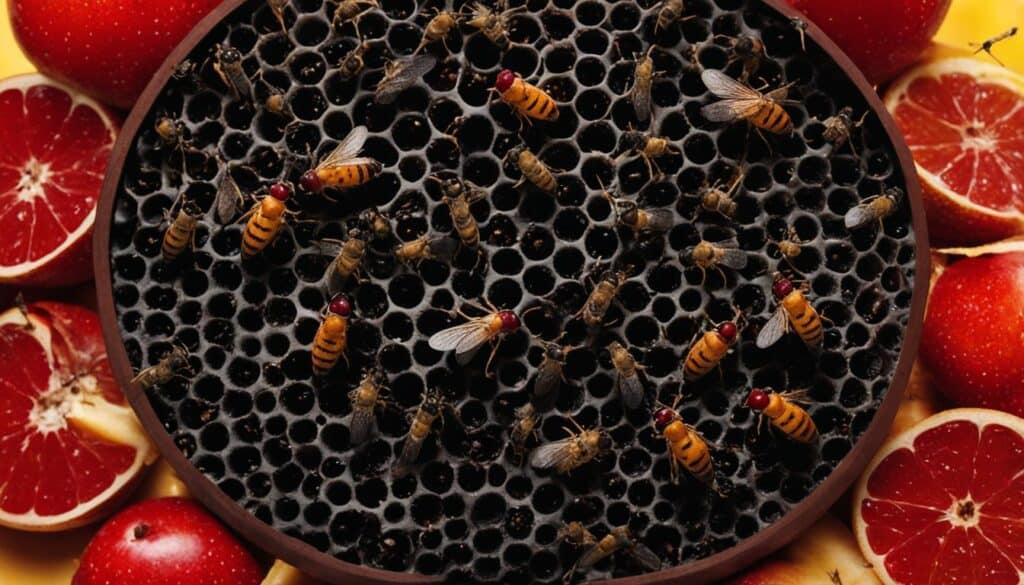
Conclusion
In conclusion, fruit fly season typically reaches its peak during the fall harvest season when fruits and vegetables have ripened. These pesky insects are attracted to ripe, decaying, or fermenting food and can often be found in garbage, compost piles, and garden areas. Fruit flies can pose a threat as carriers of bacteria and pathogens, making them a potential health hazard.
To effectively control fruit flies, it is advisable to seek assistance from a professional pest control company. Their expertise and specialized treatments can help eliminate fruit fly infestations and mitigate the risk of bacterial spread. Additionally, proactive prevention measures play a crucial role in keeping these pests at bay.
Prevention strategies include regular removal of trash, thorough inspection of produce, and proper storage of fruits and vegetables. Ensuring a clean environment and promptly addressing any potential breeding grounds can greatly reduce the risk of fruit fly infestations. By implementing these preventive measures, you can effectively manage fruit fly outbreaks and protect your home or business from these bothersome pests.
FAQ
When is fruit fly season?
Fruit fly season typically peaks during the fall harvest season when fruits and vegetables have come to maturity.
What do fruit flies look like?
Fruit flies are small flies that measure about 1/8th of an inch in length. They have red, brown, or black eyes and translucent wings. The bodies of fruit flies are usually black on top and gray on the underside, appearing tan to the human eye. Fruit fly larvae, also known as maggots, are worm-like in appearance and whitish in color except for their two dark-colored mouth hooks. Fruit flies lay their eggs on ripe, decaying, or fermenting food, which hatch into larvae and develop into adult flies.
What attracts fruit flies?
Fruit flies are attracted to ripe, decaying, or fermenting food. They are commonly found in areas with garbage, compost piles, and garden areas.
Are fruit flies dangerous?
Yes, fruit flies can be dangerous, especially when found in kitchens, pantries, and other areas where food is stored or prepared. Fruit flies can carry and spread bacteria and pathogens that can cause illness in humans.
How can fruit flies be controlled?
To control fruit flies, it is recommended to contact a professional pest control company. Fruit fly traps can catch these pests, but they do not address the source of the infestation. Professional fruit fly control services usually include a thorough inspection, accurate identification of the pest, and the development of a customized treatment plan.
What are some fruit fly prevention tips?
Preventing fruit fly infestations involves practicing proper sanitation techniques such as regularly removing trash, washing dishes, and inspecting fruits and vegetables before bringing them home. Storing fruits and vegetables in the refrigerator can also help prevent fruit fly infestations.
What are the different species of fruit flies in Hawai’i?
Managing fruit flies in Hawai’i involves dealing with four distinct species of pest fruit flies: oriental, melon, Mediterranean, and solanaceous.
What damage do fruit flies cause?
Fruit fly adults lay their eggs in the fresh flesh of fruits and vegetables, and the hatching larvae often feed on the inside of the fruit, resulting in a soft, mushy texture. Fruit flies can cause economic injury if their populations are high and they are causing severe fruit damage.
What are some prevention strategies for fruit fly damage?
Prevention strategies for fruit fly damage include practicing proper sanitation, creating a healthy ecosystem, implementing exclosure methods, and minimizing stress on plants.
How can I effectively manage fruit fly infestations?
By being proactive and following preventive measures such as regularly removing trash, inspecting produce, and properly storing fruits and vegetables, you can effectively manage fruit fly infestations and protect your home or business from these pesky pests.

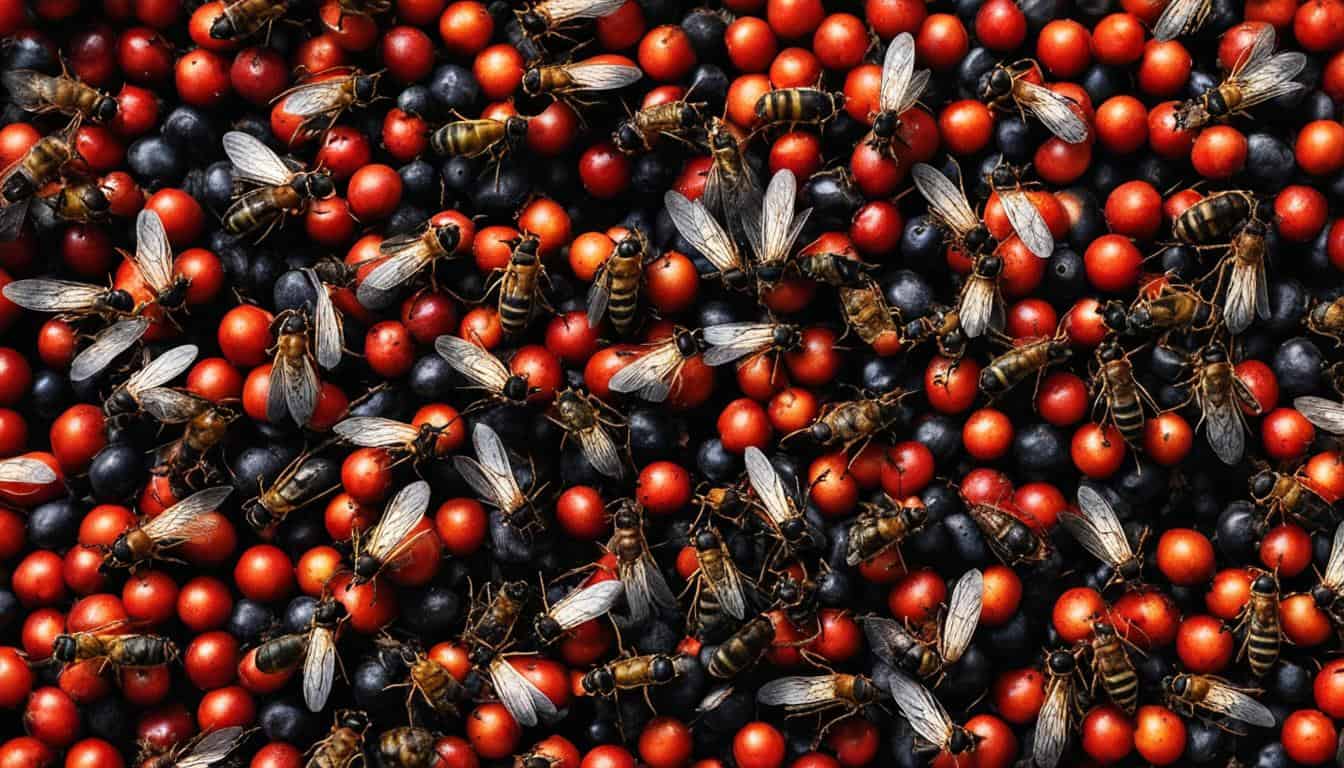



Leave a Reply